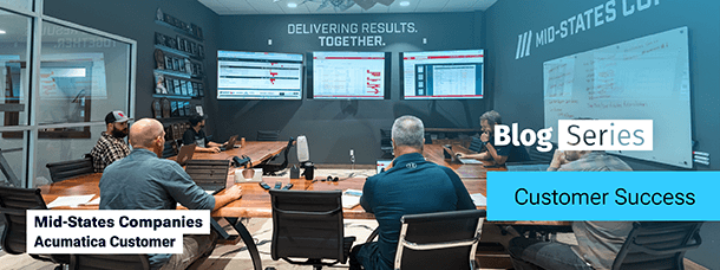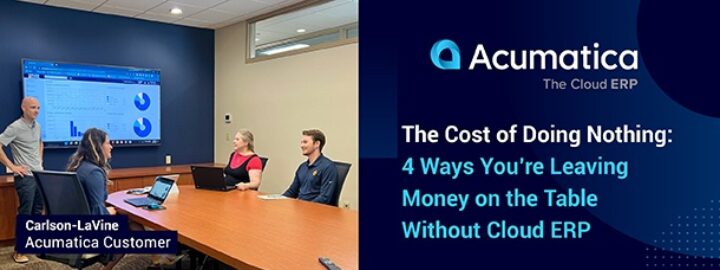Reviewed: Jun, 2023
Two competitors in a ring; only one can emerge victorious. In the case of Acumatica vs. Sage 100, the fight was over before it began.

For a business that is ready to invest in a modern, future-proofed business management solution, a thorough ERP comparison is essential if the business wants to get a return on its investment of time, money, and effort. As such, we decided to put Acumatica Cloud ERP and one of its competitors, Sage 100, in a head-to-head battle. Who will win the Acumatica vs. Sage 100 fight?
Let’s take a look.
Acumatica vs. Sage 100: A blow-by-blow account
Sage 100 came onto the ERP scene during the 1980s. In the forty years it’s been around, technology upgrades have been made, though it still relies on dated technology. As a nod to the cloud, Sage 100 customers can deploy on the Microsoft Azure cloud platform. Their target market is small-to-midsize businesses (SMBs) in discrete manufacturing, wholesale distribution, and professional services.
Acumatica Cloud ERP launched in 2008. Knowing that SMBs don’t want to frequently switch ERP systems, the founders designed Acumatica to be a solution for both today and the future. It rests on a versatile, open platform built on the world’s best cloud and mobile technology. It also brings with it the power of the channel, relying 100% on partners to sell Acumatica’s award-winning cloud ERP software.
The two competing solutions share some common traits. For example, they both offer support for multiple verticals/industries, and a large reselling partner channel (VARs). But, there are more differences than similarities.
Here are a few highlights:
- Acumatica is a true cloud product accessible via the internet using a standard browser and no software installation (or additional licensing) is needed; Sage 100 was built for on-premises deployment and modified to work with the cloud after the fact.
- Acumatica charges for computing resources used, allowing for organizational growth without penalty; Sage 100 charges per concurrent user.
- Acumatica is a fully mobile solution that is accessed on any web-enabled device and resizes to fit every page/screen; Sage 100 does not resize for every mobile device.
Critical differences, but they don’t end there.
Acumatica vs. Sage 100: Going the distance with industry functionality
While both Acumatica and Sage 100 provide industry-specific functionality, there are significant disparities. For example, while Sage 100 and Acumatica offer Bill of Materials, Work Orders, and Material Requirements Planning, only Acumatica offers native Finite Capacity Planning, Production Scheduling, Shop Floor Control, Product Configurator, Equipment Management, and more.
In Distribution and Retail, both ERP systems have Sales Order Management, Purchase Order Management, Inventory Management, and Return Merchandise Authorization (RMA). However, Acumatica features embedded Barcodes, Warehouse Management (WMS), Native eCommerce storefront integration (Shopify, BigCommerce), Native Point-of-Sale (POS) device integration, Wave Picking, Multi-Bins, and Matrix Items.
Construction and General Business modules for each company follow the same pattern. One company that implemented Sage (first Sage MAS 90 then Sage 100) and experienced these inequalities is specialty contractor Spohn Associates. Their Acumatica customer success story explains that their unique needs were not being met by Sage 100 and their in-house Access database.
On the advice of Acumatica partner Somerset CPAs and Advisors, Spohn turned to Acumatica and implemented Acumatica Construction Edition.
“Acumatica Construction Edition had everything we were looking for. We are different from regular construction contractor and liked that we could add different specialty fields and customize it to the way we do business,” says CFO Sean Barnett. “We’re relying on Acumatica Construction Edition to help us be more efficient, more productive, and allow us to do more with less over the coming months and years.”
Acumatica vs. Sage 100: Acumatica lands a knockout flurry
In the final round between Acumatica and Sage 100, Acumatica lands a flurry of knockout punches with its true cloud design, continuous innovation, and seamless integrations. Unlike Sage 100, Acumatica delivers an affordable solution updated twice a year with the latest technology. It allows organizations to connect front-office and back-office operations — integrating the systems and tools already in place — and to glean real-time information from a single, comprehensive solution that can be accessed remotely at any time.
Additionally, Acumatica provides:
- Insightful reporting and dashboards
- Best-in-class financials
- Embedded CRM
- Deep industry-specific functionality
- Dual layers of support
- Flexible deployments
Finally, Acumatica has operated with a customer-first mentality from the start, creating the industry’s first Customer Bill of Rights. Acumatica CEO Jon Roskill explains why: “We believe in protecting customers against unscrupulous business practices and are dedicated to keeping our customers’ needs and wants at the forefront of our product roadmap. Their satisfaction combined with our focus on innovation is vital to our continued reign as the fastest growing cloud ERP solution on the market.”
To hear what other customers and industry analysts have to say about Acumatica Cloud ERP, check out Info-Tech’s ERP Software Reviews: Acumatica vs. Sage (Spoiler alert: Acumatica’s Composite Score is higher); Acumatica Customer Success Stories (specifically those who replaced Sage 100 with Acumatica Cloud ERP, such as OFS and DDB); Acumatica reviews; and IDC’s ERP Vendor’s Assessed: How Modern Solutions Can Enable the Digital Enterprise.
Questions about why to choose Acumatica, especially in these challenging times? Feel free to contact our team at any time.


















